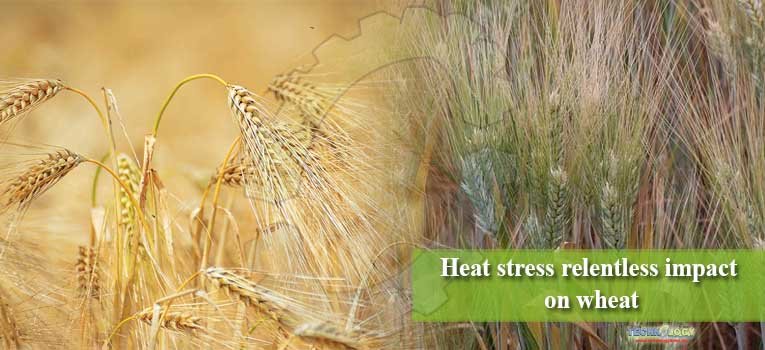Heat stress is a major environmental stress limiting wheat productivity in most cereal growing areas of the world. Wheat (Triticum aestivum L.) is produced worldwide under largely temperate but also under tropical and subtropical temperatures.
 This distribution implies the crop is versatile and adapted to various growing conditions. However high temperatures during the post-heading stages detrimentally affect its yield and sometimes grain quality.
This distribution implies the crop is versatile and adapted to various growing conditions. However high temperatures during the post-heading stages detrimentally affect its yield and sometimes grain quality.
Optimum temperature for wheat is considered 150C and it reduces yield by as much as 10–15 %. High temperature is one of the most important constraints for wheat growth and development. It decreases yield by 3–5 % per 10C rise in temperature.
According to a report of intergovernmental panel on climate change (IPCC), global mean temperature is rising at 0.30 C per decade reaching to approx. 1 and 30 C above the present value by years 2025 and 2100, respectively, and thus leading to global warming.
Plant responses to high temperatures are moderated by their inherent ability to survive that is called as basal tolerance. Also their ability to acquire tolerance to otherwise lethal temperatures that is called as acclimation. These two mechanisms in cereals are due to the activation of different genetic systems.
Direct injuries due to high temperature include protein denaturation, aggregation and increased fluidity of membrane lipids. Indirect or slower heat injuries include inactivation of enzymes in chloroplast and mitochondria inhibition of protein synthesis, protein degradation and loss of membrane integrity.
High temperature events on wheat have a response that is characterised by;
- Above optimum average temperatures for an extended period (weeks through to months)
- Heat shock which is defined by short periods (1–3 days) of very high maximum temperatures (>330C).
Temperature ranges and its effect on wheat:
The optimum temperature for grain development ranges from 12 to 220C. While optimum temperatures of 22, 10.6, 21 and 20.70C for sowing-emergence, terminal spikelet, anthesis and grain filling, periods, respectively.
Above optimum temperatures especially during grain filling impact on yield through both grain number and weight with grain weight the most sensitive yield component.
Accelerated crop development, due to increased temperature, limits the duration of the grain filling period. While high temperatures can increase the supply of assimilate during grain filling. The wheat plant is unable to fully compensate for the shorter duration of the grain filling period.
Heat effect at a physiological level:
Short periods of high temperature (35–400C), during grain filling, could have a negative effect on yield and quality. At a physiological level, particularly at cellular membranes level, the heat stress effects after anthesis are complex.
It integrate wheat responses to periods with moderate high temperatures (25/320C) and plant behaviours to short periods with high temperatures (>32-350C ). Lipids and proteins form dynamic structures of the cellular membranes.
It supports many biophysical and biochemical, with permeable selective barriers allow the development of many biological responses. But they are also a main target of environmental stresses, therefore having an essential role in the adaptation to environmental adverse conditions.
High temperatures accelerate the initial grain growth rate but shorten the grain growth period. Consequently, the final grain weight is much reduced at higher temperatures. High growth temperatures affect the physical properties of the seed including seed size, seed dimensions, seed coat and the final appearance of the seed.
Heat effect during the reproductive phase:
The sensitivity of wheat to heat is greatest during the reproductive period. Particularly after heading which corresponds to the period in the growing season where high temperatures are most common. Wheat experiences heat stress to varying degrees at different phonological stages. But heat stress during the reproductive phase is more harmful than during the vegetative phase.
Due to the direct effect on grain number and dry weight. End-of-season or terminal heat stress is also likely to increase for wheat in near future. Hence the main focus is on responses to elevated temperatures during reproductive and grain-filling stages and processes that affect grain yield.
The optimum temperature for wheat anthesis and grain filling ranges from 12 to 220C. Exposure to temperatures above this can significantly reduce grain yield.
Heat effect on photosynthesis:
Photosynthesis is one of the most heat-sensitive processes. And decreases of photosynthetic rate under high temperatures may result in significant reduction of plant growth. Acclimate to high temperatures is closely associated with the acclimation capacity at the photosynthesis level.
Photosynthesis is extremely heat-sensitive process. Heat inhibits the photosynthesis process completely. And decreases in photosynthesis may result from the inhibition of photosystem II (PSII) activity. PS II is considered as most thermally labile component of the photosynthetic electron transport chain.
The inhibition of PSII also leads to a decrease in variable chlorophyll fluorescence. Which is a sensitive and reliable method for the detection and quantification of temperature-induced changes to the photosynthetic apparatus.